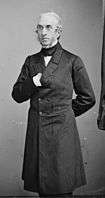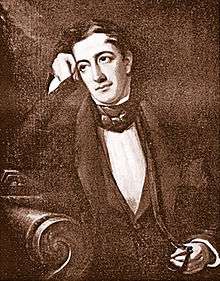United States House of Representatives elections, 1848
| | |||||||||||||||||||||||||||||||||||||||||||||||||||||||||||||||
| |||||||||||||||||||||||||||||||||||||||||||||||||||||||||||||||
| |||||||||||||||||||||||||||||||||||||||||||||||||||||||||||||||
| |||||||||||||||||||||||||||||||||||||||||||||||||||||||||||||||
Elections to the United States House of Representatives for the 31st Congress were held at various dates in each state between August 7, 1848 (Arkansas, Illinois, Iowa and Missouri) and November 6, 1849 (Mississippi). California also elected two Representatives at-large on November 11, 1849, in anticipation of statehood. They were seated September 11, 1850.
The Democrats gained one seat, while the Whigs lost their majority they had gained just two years earlier in the election of 1846. This was the first election in the U.S. House that resulted in no party gaining an overall majority of seats.
The Mexican–American War, which ended with an American victory several months before the election, was a big factor in the election. Zachary Taylor, a general in the war, was elected president as a Whig, but the Democrats, who instigated the war, were rewarded for their victory by regaining the largest share of House seats. The fiercely abolitionist Free Soil Party was a huge spoiler in this election, earning 9 seats in districts that generally supported Whig politicians. At the same time, the American (Know Nothing) Party continued to be a marginal force after their breakthrough in the 1844 elections, managing to win just 1 seat in 1848, just as they had previously in 1846. In addition, the new state of California opted to elect an Independent, George Washington Wright, as one of its two representatives, in elections held in 1849.
When Congress assembled on December 3, 1849, no single party was able to win a majority of the vote for Speaker of the House. The Whigs split; the majority renominating Robert Charles Winthrop of Massachusetts but the southern Whigs split off to support Meredith Poindexter Gentry of Tennessee. The Democrats put forth Howell Cobb of Georgia, while the Free Soilers supported David Wilmot of Pennsylvania, author of the Wilmot Proviso.
The impasse continued until the 63rd ballot. Two dozen other candidates were offered in the hopes that someone else could gain a majority. The Democrats and Free Soilers attempted a compromise on the 40th ballot, but this was exposed when Edward Stanly, a Whig from North Carolina, exposed the deal. After the 59th ballot, Stanly offered a proposal, which was accepted. The House would take three additional ballots. If no candidate won the majority, whoever placed first on the 63rd ballot would be declared the new Speaker. On December 22, Cobb was chosen on the 63rd ballot with 102 votes to 99 for Winthrop and 20 scattering.
Election summaries
Wisconsin was apportioned an additional seat in 1848,[1] and two more seats were added for the new state of California.[2]
| 113 | 9 | 1 | 1 | 108 |
| Democratic | FS | I | AKN | Whig |
| State | Type | Date | Total seats |
Democratic | Whig | Free Soil | Other | ||||
|---|---|---|---|---|---|---|---|---|---|---|---|
| Seats | Change | Seats | Change | Seats | Change | Seats | Change | ||||
| Michigan | District | November 7, 1848 (Election Day)[Note 3] |
3 | 2 | 1 | 0 | 0 | ||||
| New Jersey | District | 5 | 1 | 4 | 0 | 0 | |||||
| New York | District | 34 | 1 | 32 | 1 | 0 | |||||
| Wisconsin | District | 3[Note 4] | 1 | 1 | 1 | 0 | |||||
| Arkansas | At-large | August 7, 1848 | 1 | 1 | 0 | 0 | 0 | ||||
| Delaware | At-large | November 6, 1848 | 1 | 0 | 1 | 0 | 0 | ||||
| Florida | At-large | October 2, 1848 | 1 | 0 | 1 | 0 | 0 | ||||
| Georgia | District | October 2, 1848 | 8 | 4 | 4 | 0 | 0 | ||||
| Illinois | District | August 7, 1848 | 7 | 6 | 1 | 0 | 0 | ||||
| Iowa | District | August 7, 1848 | 2 | 2 | 0 | 0 | 0 | ||||
| Maine | District | September 11, 1848 | 7 | 5 | 2 | 0 | 0 | ||||
| Massachusetts | District | November 13, 1848 | 10[Note 5] | 0 | 8 | 1 | 0 | ||||
| Missouri | District | August 7, 1848 | 5 | 5 | 0 | 0 | 0 | ||||
| Ohio | District | October 10, 1848 | 21 | 11 | 8 | 2 | 0 | ||||
| Pennsylvania | District | October 10, 1848 | 24 | 9 | 13 | 1 | 1[Note 6] | ||||
| South Carolina | District | October 9–10, 1848 | 7 | 7 | 0 | 0 | 0 | ||||
| Vermont | District | September 5, 1848 | 4 | 1 | 3 | 0 | 0 | ||||
| 1849 elections | |||||||||||
| Alabama | District | August 6, 1849 | 7 | 5 | 2 | 0 | 0 | ||||
| California | At-large | November 11, 1849[Note 7] | 2 | 1 | 0 | 0 | 1[Note 8] | ||||
| Connecticut | District | April 2, 1849 | 4 | 2 | 1 | 1 | 0 | ||||
| Indiana | District | August 6, 1849 | 10 | 8 | 1 | 1 | 0 | ||||
| Kentucky | District | August 6, 1849 | 10 | 4 | 6 | 0 | 0 | ||||
| Louisiana | District | November 5, 1849 | 4 | 3 | 1 | 0 | 0 | ||||
| Maryland | District | October 3, 1849 | 6 | 3 | 3 | 0 | 0 | ||||
| Mississippi | District | November 5–6, 1849 | 4 | 4 | 0 | 0 | 0 | ||||
| New Hampshire | District | March 13, 1849 | 4 | 2 | 1 | 1 | 0 | ||||
| North Carolina | District | August 7, 1849 | 9 | 3 | 6 | 0 | 0 | ||||
| Rhode Island | District | April 4, 1849 | 2 | 0 | 2 | 0 | 0 | ||||
| Tennessee | District | August 2, 1849 | 11 | 7 | 4 | 0 | 0 | ||||
| Texas | District | August 6, 1849 | 2 | 2 | 0 | 0 | 0 | ||||
| Virginia | District | April 26, 1849 | 15 | 13 | 2 | 0 | 0 | ||||
| Total[Note 2] | 232 | 113 48.7% |
|
108 46.6% |
|
9 3.9% |
|
2 0.9% |
| ||
Complete returns
California
| District | Incumbent | Party | First elected |
Result | Candidates |
|---|---|---|---|---|---|
| California at-large 2 seats on a general ticket |
None (District created) | Independent gain | George W. Wright (I) 22% Edward Gilbert (D) 20.6% Rodman M. Price 16.3% P. A. Morse 8.3% Lewis Dent 8.2% E. J. C. Kewen 7.3% W. M. Sheppard 7.2% William E. Shannon 5.4% Peter Halsted 2.4% L. W. Hastings 0.9% Pierson B. Reading 0.7% W. H. Russell 0.4% J. S. Thompson 0.3% Kimball H. Dimmick 0.2% | ||
| None (District created) | Democratic gain | ||||
Florida
| District | Incumbent | Party | First elected |
Result | Candidates |
|---|---|---|---|---|---|
| Florida at-large | Edward C. Cabell | Whig | 1846 | Re-elected | Edward C. Cabell (W) 53.5% William Pope Duval (D) 46.5% |
See also
Notes
- ↑ Excludes states admitted during the 31st Congress
- 1 2 3 Includes late elections
- ↑ In 1845, Congress passed a law providing for a uniform date for choosing presidential electors (see: Statutes at Large, 28th Congress, 2nd Session, p. 721). Congressional elections were unaffected by this law, but the date was gradually adopted by the states for Congressional elections as well.
- ↑ Increase of 1 seat
- ↑ One vacancy, in MA-04, for the duration of the 31st Congress (as no candidate received a majority of the vote after multiple elections).
- ↑ 1 Know-Nothing
- ↑ Seated September 11, 1850 after admission to the Union.
- ↑ 1 Independent elected.
- ↑ Previous election had 1 Independent
References
Bibliography
- Dubin, Michael J. (March 1, 1998). United States Congressional Elections, 1788-1997: The Official Results of the Elections of the 1st Through 105th Congresses. McFarland and Company. ISBN 978-0786402830.
- Martis, Kenneth C. (January 1, 1989). The Historical Atlas of Political Parties in the United States Congress, 1789-1989. Macmillan Publishing Company. ISBN 978-0029201701.
- Moore, John L., ed. (1994). Congressional Quarterly's Guide to U.S. Elections (Third ed.). Congressional Quarterly Inc. ISBN 978-0871879967.
- "Party Divisions of the House of Representatives* 1789–Present". Office of the Historian, House of United States House of Representatives. Retrieved January 21, 2015.
External links
- Office of the Historian (Office of Art & Archives, Office of the Clerk, U.S. House of Representatives)



